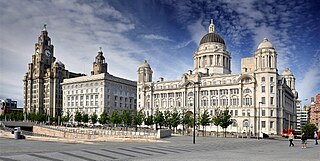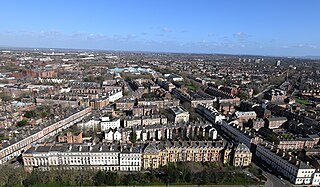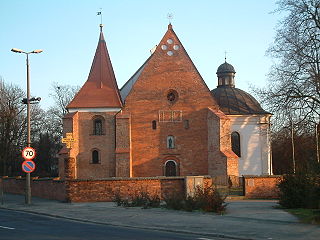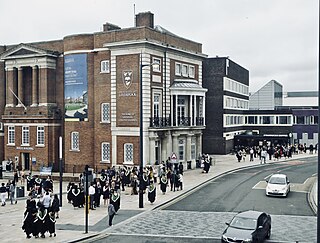
Liverpool is a city and metropolitan borough in Merseyside, northwest England. It had a population of 496,770 in 2022. The city is located on the eastern side of the Mersey Estuary, adjacent to the Irish Sea, and is approximately 178 miles (286 km) from London. Liverpool is the fifth largest city in the United Kingdom, the largest settlement in Merseyside and part of the Liverpool City Region, a combined authority with a population of over 1.5 million.

Merseyside is a ceremonial and metropolitan county in North West England. It borders Lancashire to the north, Greater Manchester to the east, Cheshire to the south, the Welsh county of Flintshire across the Dee Estuary to the southwest, and the Irish Sea to the west. The largest settlement is the city of Liverpool.

Liverpool Metropolitan Cathedral, officially known as the Metropolitan Cathedral of Christ the King and locally nicknamed "Paddy's Wigwam", is the seat of the Archbishop of Liverpool and the mother church of the Roman Catholic Archdiocese of Liverpool in Liverpool, England. The Grade II* Metropolitan Cathedral is one of Liverpool's many listed buildings.

Gambier Terrace is a street of 19th-century houses overlooking St. James's Mount and Gardens and Liverpool Cathedral. It is generally reckoned to be in Canning, although it falls within the Rodney Street conservation area, together with Hope Street and Rodney Street.

The Liverpool Institute for Performing Arts (LIPA) is a performing arts higher education institution in Liverpool, founded by Paul McCartney and Mark Featherstone-Witty and opened in 1996. LIPA offers 11 full-time BA (Hons) degrees in a range of fields across the performing arts, as well as three Foundation Certificate programmes of study in acting, music technology, and dance and popular music. LIPA offers full-time, one-year master's-level degree courses in acting (company) and costume making. It is a member of the Federation of Drama Schools.

David Stuart Sheppard, Baron Sheppard of Liverpool was a Church of England bishop who played cricket for Sussex and England in his youth, before serving as Bishop of Liverpool from 1975 to 1997. Sheppard remains the only ordained minister to have played Test cricket, though others such as Tom Killick were ordained after playing Tests.

Liverpool Cathedral is a Church of England cathedral in the city of Liverpool, England. It is the seat of the bishop of Liverpool and is the mother church of the diocese of Liverpool. The church may be formally referred to as the Cathedral Church of Christ in Liverpool the Cathedral Church of the Risen Christ, Liverpool. It is the largest cathedral and religious building in Britain, and the eighth largest church in the world.

London has, alongside New York, been described as the cultural capital of the world. The culture of London concerns the music, museums, festivals, and lifestyle within London, the capital city of the United Kingdom. London is one of the world's leading business centres, renowned for its technological readiness and economic clout, as well as attracting the most foreign investment of any global city.

Canning is an area on the eastern edge of Liverpool city centre, England, characterised by almost entirely residential Georgian architecture. Parts of the district are included in Liverpool's Knowledge Quarter. It borders the rest of the Knowledge Quarter to the north, the district of Toxteth to the south, Edge Hill to the east and Ropewalks, Chinatown and the Baltic Triangle to the west. The area takes its name from one of its principal thoroughfares, Canning Street, which is named after George Canning, (1770–1827), a British politician who served as Foreign Secretary and, briefly, Prime Minister.

Rodney Street in Liverpool, England, is noted for the number of doctors who practise there and its Georgian architecture. It is sometimes referred to as the "Harley Street of the North". Together with Hope Street and Gambier Terrace it forms the Rodney Street conservation area. There are over 60 Grade II listed buildings on the street and one Grade II* former church.
Grade I, Grade II* and notable Grade IIlisted buildings in the metropolitan boroughs of Knowsley, Liverpool, Sefton, St Helens and Wirral in Merseyside.
Australian non-residential architectural styles are a set of Australian architectural styles that apply to buildings used for purposes other than residence and have been around only since the first colonial government buildings of early European settlement of Australia in 1788.

Birmingham city centre, also known as Central Birmingham, is the central business district of Birmingham, England. The area was historically in Warwickshire. Following the removal of the Inner Ring Road, the city centre is now defined as being the area within the Middle Ring Road. The city centre is undergoing massive redevelopment with the Big City Plan, which means there are now nine emerging districts and the city centre is approximately five times bigger.

The Royal-Imperial Route in Poznań is a tourist walk running through the most important parts of the city and presenting the history, culture and identity of Poznań. The Route leads in a westward direction, from The Church of St. John Jerusalem behind the Wall to the Church of the Sacred Heart of Jesus and St. Florian.

The architecture of Liverpool is rooted in the city's development into a major port of the British Empire. It encompasses a variety of architectural styles of the past 300 years, while next to nothing remains of its medieval structures which would have dated back as far as the 13th century. Erected 1716–18, Bluecoat Chambers is supposed to be the oldest surviving building in central Liverpool.

Liverpool is a city and port in Merseyside, England, which contains many listed buildings. A listed building is a structure designated by English Heritage of being of architectural and/or of historical importance and, as such, is included in the National Heritage List for England. There are three grades of listing, according to the degree of importance of the structure. Grade I includes those buildings that are of "exceptional interest, sometimes considered to be internationally important"; the buildings in Grade II* are "particularly important buildings of more than special interest"; and those in Grade II are "nationally important and of special interest". Very few buildings are included in Grade I — only 2.5% of the total. Grade II* buildings represent 5.5% of the total, while the great majority, 92%, are included in Grade II.

Liverpool city centre is the commercial, cultural, financial and historical centre of Liverpool and the Liverpool City Region, England. Different definitions of the city centre exist for urban planning and local government, however, the border of Liverpool city centre is broadly marked by the inner city districts of Vauxhall, Everton, Edge Hill, Kensington and Toxteth.

The "Knowledge Quarter" is an area of Liverpool city centre covering 450 acres, incorporating the vicinity around London Road, Islington, the so called 'Fabric District', Paddington Village and part of Canning.

















